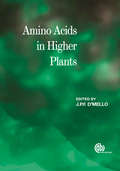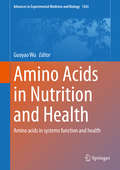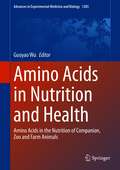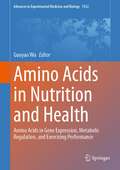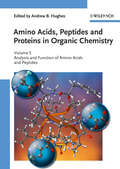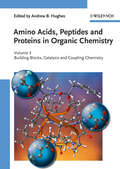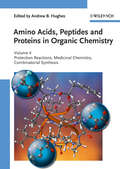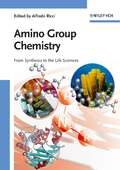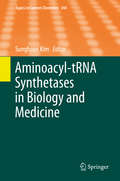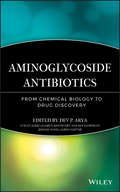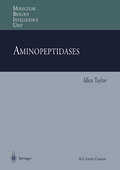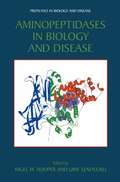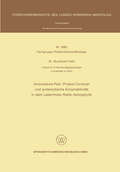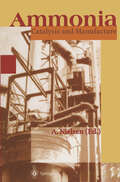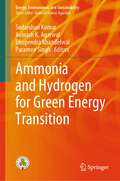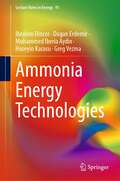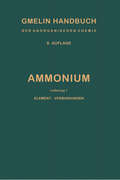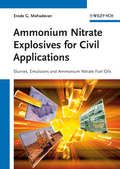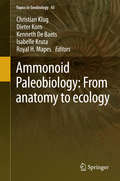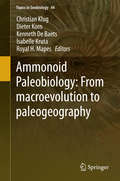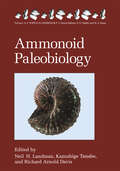- Table View
- List View
Amino Acids in Higher Plants
by G Osuji A Raychaudhuri Z-H He A. O Hudson C Sengupta-Gopalan S. M Duff F Gallardo E Gonzales-Vigil F. J Corpas Autar K Mattoo R Hoefgen I Garcia Fernandez R Azevedo R Ingle L. V Nguyen E Planchet S Okumoto S Pfautsch J. W Chandler A Ishihara M Banon Arnao H Stotz S. O Duke D. A Saltmiras E Lewinsohn J Thomas S Rutherfurd S. C Minocha C. L LevesqueAmino acids play a role in the defence mechanisms and stress responses of plants, as well as in food quality and safety for humans and animals. Recent advances in the field make a comprehensive overview of the information a necessity; this book collates chapters on plant enzymes and metabolism, modulation, molecular aspects and secondary products. Also including information on ecology, the environment and mammalian nutrition and toxicology, it provides an authoritative resource.
Amino Acids in Nutrition and Health: Amino acids in systems function and health (Advances in Experimental Medicine and Biology #1265)
by Guoyao WuThis edited volume comprehensively highlights recent advances in the metabolism, nutrition, physiology, and pathobiology of amino acids in all the systems of humans and other animals (including livestock, poultry, companion animals, and fish). It enables readers to understand the crucial roles of amino acids and their metabolites in the health and diseases of the circulatory, digestive, endocrine, immune, muscular, nervous, reproductive, respiratory, skeletal, and urinary systems, as well as the sense organs (eyes, ears, nose, skin, and tongue). Readers will learn that amino acids are not only the building blocks of protein, but are also signalling molecules, as well as regulators of gene expression, metabolic processes and developmental changes in the body. This knowledge will guide nutritional practices to improve the growth, development and health of humans and other animals, as well as prevent and treat chronic (e.g., obesity, diabetes, and cardiovascular disorders) and infectious (e.g., bacterial, fungal, parasite, and viral) diseases. Editor of this volume is an internationally recognized expert in nutritional biochemistry. He has over 38 years of experience with research and teaching at world-class universities in the area of amino acid biochemistry, nutrition, and physiology. He has published more than 625 papers in peer-reviewed journals, 62 chapters in books, and authored two text/reference books, with an H-index of 117 and more than 55,000 citations in Google Scholar. This publication is a useful reference for professionals as well as undergraduate and graduate students in animal science, biochemistry, biomedical engineering, biology, human medicine, food science, kinesiology, nursing, nutrition, pharmacology, physiology, toxicology, veterinary medicine, and other related disciplines. In addition, all chapters provide general and specific references to amino acids in systems health for researchers and practitioners in biomedicine, animal and plant agriculture, and aquaculture, and for government policy makers.
Amino Acids in Nutrition and Health: Amino Acids in the Nutrition of Companion, Zoo and Farm Animals (Advances in Experimental Medicine and Biology #1285)
by Guoyao WuAmino acids (AAs) are not only building blocks of protein, but are also signalling molecules as well as regulators of gene expression and the protein phosphorylation cascade. Additionally, AAs are key precursors for syntheses of hormones and low-molecular weight nitrogenous substances with each having enormous biological importance. For example, physiological concentrations of AA metabolites (e.g., nitric oxide, polyamines, glutathione, taurine, thyroid hormones, and serotonin) are required for cell functions. Growing evidence shows that humans and animals have dietary requirements for all proteinogenic AAs. Mammals, birds and fish also have species- and age-dependent needs for some AA-related substances. However, elevated levels of other products (e.g., ammonia, homocysteine, H2S, and asymmetric dimethylarginine) are pathogenic factors for neurological disorders, oxidative stress, and cardiovascular disease. Thus, optimal amounts of AAs and their ratios in diets and circulation are crucial for whole body homeostasis and health. Adequate provision of one or a mixture of functional AAs or metabolites may be beneficial for ameliorating health problems at various stages of the life cycle (e.g., fetal growth restriction, neonatal morbidity and mortality, weaning-associated intestinal dysfunction and wasting syndrome, obesity, diabetes, cardiovascular disease, the metabolic syndrome, and infertility). Dietary supplementation of these nutrients can also optimize the efficiency of metabolic transformations to enhance muscle growth, milk production, and athletic performance, while preventing excess fat deposition and reducing adiposity. Therefore, functional AAs hold great promise in improving the growth, health and well-being of individuals.Chapter 7 is available open access under a Creative Commons Attribution 4.0 International License via link.springer.com.
Amino Acids in Nutrition and Health: Amino Acids in Gene Expression, Metabolic Regulation, and Exercising Performance (Advances in Experimental Medicine and Biology #1332)
by Guoyao WuThis book explains about amino acids (AAs) which are not only building blocks of protein, but are also signaling molecules as well as regulators of gene expression and the protein phosphorylation cascade. Additionally, AAs are key precursors for syntheses of hormones and low-molecular-weight nitrogenous substances with each having enormous biological importance. For example, physiological concentrations of AA metabolites (e.g., nitric oxide, polyamines, glutathione, taurine, thyroid hormones, and serotonin) are required for cell functions. Growing evidence shows that humans and animals have dietary requirements for all proteinogenic AAs. Mammals, birds, and fish also have species- and age-dependent needs for some AA-related substances. However, elevated levels of other products (e.g., ammonia, homocysteine, H2S, and asymmetric dimethylarginine) are pathogenic factors for neurological disorders, oxidative stress, and cardiovascular disease. Thus, optimal amounts of AAs and their ratios in diets and circulation are crucial for whole-body homeostasis and health. Adequate provision of one or a mixture of functional AAs or metabolites may be beneficial for ameliorating health problems at various stages of the life cycle (e.g., fetal growth restriction, neonatal morbidity and mortality, weaning-associated intestinal dysfunction and wasting syndrome, obesity, diabetes, cardiovascular disease, the metabolic syndrome, and infertility). Dietary supplementation of these nutrients can also optimize the efficiency of metabolic transformations to enhance muscle growth, milk production, and athletic performance, while preventing excess fat deposition and reducing adiposity. Therefore, functional AAs hold great promise in improving the growth, health, and well-being of individuals.
Amino Acids, Peptides and Proteins in Organic Chemistry, Analysis and Function of Amino Acids and Peptides (Amino Acids, Peptides and Proteins in Organic Chemistry (VCH))
by Andrew B. HughesThis is the last of five books in the Amino Acids, Peptides and Proteins in Organic Synthesis series. Closing a gap in the literature, this is the only series to cover this important topic in organic and biochemistry. Drawing upon the combined expertise of the international "who's who" in amino acid research, these volumes represent a real benchmark for amino acid chemistry, providing a comprehensive discussion of the occurrence, uses and applications of amino acids and, by extension, their polymeric forms, peptides and proteins. The practical value of each volume is heightened by the inclusion of experimental procedures. The 5 volumes cover the following topics: Volume 1: Origins and Synthesis of Amino Acids Volume 2: Modified Amino Acids, Organocatalysis and Enzymes Volume 3: Building Blocks, Catalysis and Coupling Chemistry Volume 4: Protection Reactions, Medicinal Chemistry, Combinatorial Synthesis Volume 5: Analysis and Function of Amino Acids and Peptides Volume 5 of this series presents a wealth of methods to analyze amino acids and peptides. Classical approaches are described, such as X-ray analysis, chromatographic methods, NMR, AFM, mass spectrometry and 2D-gel electrophoresis, as well as newer approaches, including Surface Plasmon Resonance and array technologies. Originally planned as a six volume series, Amino Acids, Peptides and Proteins in Organic Chemistry now completes with five volumes but remains comprehensive in both scope and coverage. Further information about the 5 Volume Set and purchasing details can be viewed here.
Amino Acids, Peptides and Proteins in Organic Chemistry, Building Blocks, Catalysis and Coupling Chemistry (Amino Acids, Peptides and Proteins in Organic Chemistry (VCH))
by Andrew B. HughesThis is the third of five books in the Amino Acids, Peptides and Proteins in Organic Synthesis series. Closing a gap in the literature, this is the only series to cover this important topic in organic and biochemistry. Drawing upon the combined expertise of the international "who's who" in amino acid research, these volumes represent a real benchmark for amino acid chemistry, providing a comprehensive discussion of the occurrence, uses and applications of amino acids and, by extension, their polymeric forms, peptides and proteins. The practical value of each volume is heightened by the inclusion of experimental procedures. The 5 volumes cover the following topics: Volume 1: Origins and Synthesis of Amino Acids Volume 2: Modified Amino Acids, Organocatalysis and Enzymes Volume 3: Building Blocks, Catalysis and Coupling Chemistry Volume 4: Protection Reactions, Medicinal Chemistry, Combinatorial Synthesis Volume 5: Analysis and Function of Amino Acids and Peptides This third volume in the series presents an in depth account of recent developments in the (bio-)synthesis of amino acids and peptides. Divided into two parts, the first section deals with amino acids as building blocks, including the generation of alpha-amino acids, beta-lactams, and heterocycles. The second section is devoted to the synthesis of peptides, with the focus on solid phase synthesis. However, solution phase peptide synthesis is covered as well, as are topics such as coupling reagents, chemical ligation, peptide purification and automation. Originally planned as a six volume series, Amino Acids, Peptides and Proteins in Organic Chemistry now completes with five volumes but remains comprehensive in both scope and coverage. Further information about the 5 Volume Set and purchasing details can be viewed here.
Amino Acids, Peptides and Proteins in Organic Chemistry, Building Blocks, Catalysis and Coupling Chemistry: Protection Reactions, Medicinal Chemistry, Combinatorial Synthesis (Amino Acids, Peptides and Proteins in Organic Chemistry (VCH) #2)
by Andrew B. HughesThis is the third of five books in the Amino Acids, Peptides and Proteins in Organic Synthesis series. Closing a gap in the literature, this is the only series to cover this important topic in organic and biochemistry. Drawing upon the combined expertise of the international "who's who" in amino acid research, these volumes represent a real benchmark for amino acid chemistry, providing a comprehensive discussion of the occurrence, uses and applications of amino acids and, by extension, their polymeric forms, peptides and proteins. The practical value of each volume is heightened by the inclusion of experimental procedures. The 5 volumes cover the following topics: Volume 1: Origins and Synthesis of Amino Acids Volume 2: Modified Amino Acids, Organocatalysis and Enzymes Volume 3: Building Blocks, Catalysis and Coupling Chemistry Volume 4: Protection Reactions, Medicinal Chemistry, Combinatorial Synthesis Volume 5: Analysis and Function of Amino Acids and Peptides This third volume in the series presents an in depth account of recent developments in the (bio-)synthesis of amino acids and peptides. Divided into two parts, the first section deals with amino acids as building blocks, including the generation of alpha-amino acids, beta-lactams, and heterocycles. The second section is devoted to the synthesis of peptides, with the focus on solid phase synthesis. However, solution phase peptide synthesis is covered as well, as are topics such as coupling reagents, chemical ligation, peptide purification and automation. Originally planned as a six volume series, Amino Acids, Peptides and Proteins in Organic Chemistry now completes with five volumes but remains comprehensive in both scope and coverage. Further information about the 5 Volume Set and purchasing details can be viewed here.
Amino Acids, Peptides and Proteins in Organic Chemistry, Protection Reactions, Medicinal Chemistry, Combinatorial Synthesis: Protection Reactions, Medicinal Chemistry, Combinatorial Synthesis (Amino Acids, Peptides and Proteins in Organic Chemistry (VCH))
by Andrew B. HughesThis is the fourth of five books in the Amino Acids, Peptides and Proteins in Organic Synthesis series. Closing a gap in the literature, this is the only series to cover this important topic in organic and biochemistry. Drawing upon the combined expertise of the international "who's who" in amino acid research, these volumes represent a real benchmark for amino acid chemistry, providing a comprehensive discussion of the occurrence, uses and applications of amino acids and, by extension, their polymeric forms, peptides and proteins. The practical value of each volume is heightened by the inclusion of experimental procedures. The 5 volumes cover the following topics: Volume 1: Origins and Synthesis of Amino Acids Volume 2: Modified Amino Acids, Organocatalysis and Enzymes Volume 3: Building Blocks, Catalysis and Coupling Chemistry Volume 4: Protection Reactions, Medicinal Chemistry, Combinatorial Synthesis Volume 5: Analysis and Function of Amino Acids and Peptides The fourth volume in this series is structured in three main sections. The first section is about protection reactions and amino acid based peptidomimetics. The second, and most extensive, part is devoted to the medicinal chemistry of amino acids. It includes, among others, the chemistry of alpha- and beta amino acids, peptide drugs, and advances in N- and O-glycopeptide synthesis. The final part deals with amino acids in combinatorial synthesis. Methods, such as phage display, library peptide synthesis, and computational design are described. Originally planned as a six volume series, Amino Acids, Peptides and Proteins in Organic Chemistry now completes with five volumes but remains comprehensive in both scope and coverage. Further information about the 5 Volume Set and purchasing details can be viewed here.
Amino Acids, Peptides and Proteins in Organic Chemistry, Protection Reactions, Medicinal Chemistry, Combinatorial Synthesis: Protection Reactions, Medicinal Chemistry, Combinatorial Synthesis (Amino Acids, Peptides and Proteins in Organic Chemistry (VCH) #2)
by Andrew B. HughesThis is the fourth of five books in the Amino Acids, Peptides and Proteins in Organic Synthesis series. Closing a gap in the literature, this is the only series to cover this important topic in organic and biochemistry. Drawing upon the combined expertise of the international "who's who" in amino acid research, these volumes represent a real benchmark for amino acid chemistry, providing a comprehensive discussion of the occurrence, uses and applications of amino acids and, by extension, their polymeric forms, peptides and proteins. The practical value of each volume is heightened by the inclusion of experimental procedures. The 5 volumes cover the following topics: Volume 1: Origins and Synthesis of Amino Acids Volume 2: Modified Amino Acids, Organocatalysis and Enzymes Volume 3: Building Blocks, Catalysis and Coupling Chemistry Volume 4: Protection Reactions, Medicinal Chemistry, Combinatorial Synthesis Volume 5: Analysis and Function of Amino Acids and Peptides The fourth volume in this series is structured in three main sections. The first section is about protection reactions and amino acid based peptidomimetics. The second, and most extensive, part is devoted to the medicinal chemistry of amino acids. It includes, among others, the chemistry of alpha- and beta amino acids, peptide drugs, and advances in N- and O-glycopeptide synthesis. The final part deals with amino acids in combinatorial synthesis. Methods, such as phage display, library peptide synthesis, and computational design are described. Originally planned as a six volume series, Amino Acids, Peptides and Proteins in Organic Chemistry now completes with five volumes but remains comprehensive in both scope and coverage. Further information about the 5 Volume Set and purchasing details can be viewed here.
Amino Group Chemistry: From Synthesis to the Life Sciences
by Alfredo RicciHere, probably the most important functional group in organic chemistry is discussed in one handy volume. The monograph covers its application -- from natural products to synthetic pharmaceuticals -- detailing complex syntheses using the amino group as templates and modern techniques focussing on the introduction of the amino group. A definitive must-have for every chemist.
Aminoacyl-tRNA Synthetases in Biology and Medicine (Topics in Current Chemistry #344)
by Sunghoon KimThis book will focus on new molecular interactions and novel activities and the associated diseases that have been recently discovered from the studies of eukaryotic and mammalian aminoacyl-tRNA synthetases. In addition, the potential applications of ARS researches in biotechnology and medicine will be addressed.
Aminoglycoside Antibiotics: From Chemical Biology to Drug Discovery (Wiley Series in Drug Discovery and Development #5)
by Dev P. AryaAdvances that open new avenues in developing aminoglycoside antibiotics During the last twenty years, there have been numerous advances in the understanding of the chemistry, biochemistry, and recognition of aminoglycosides. This has led to the development of novel antibiotics and opened up new therapeutic targets for intervention. This is the first book to provide a complete overview of recent advances in the field and explore their tremendous potential for drug discovery and rational drug design. With chapters written by one or more leading experts in their specialty areas, the book addresses the chemistry, biology, and toxicology of aminoglycosides. Aminoglycoside Antibiotics: From Chemical Biology to Drug Discovery is a great resource for academic and industrial researchers in drug design and mechanism studies and for researchers studying antibiotic resistance, antibiotic design and synthesis, and the discovery of novel pharmaceuticals. It is also a valuable reference for graduate students in pharmacy, pharmaceutical science, biophysics, medicinal chemistry, and chemical biology.
Aminopeptidases (Molecular Biology Intelligence Unit)
by Allen TaylorThis book summarizes recently gathered information regarding the aminopeptidases. Nomenclature, distributions in the plant and animal kingdoms, structural and compositional information, mechanistic studies, homologies, physiological, medical and industrial uses, and molecular genetics of aminopeptidases are described.
Aminopeptidases in Biology and Disease (Proteases in Biology and Disease #2)
by Nigel M. Hooper Uwe LendeckelAminopeptidases in Biology and Disease provides a comprehensive review of the emerging role of aminopeptidases in a range of biological processes and disease situations. Processes as diverse as angiogenesis, antigen presentation, neuropeptide and hormone processing, pregnancy and reproduction, protein turnover, memory, inflammation, tumour growth, cancer and metastasis, blood pressure and hypertension all critically involve one or more aminopeptidases. The individual chapters have been written by experts in the field who have provided detailed accounts of the central roles played by various aminopeptidases in biology and disease.
Aminosäure-Pool, Protein-Turnover und proteolytische Enzymaktivität in dem Lebermoos Riella helicophylla (Forschungsberichte des Landes Nordrhein-Westfalen #3065)
by Burckhard ViellAmmonia: Catalysis and Manufacture
by K. Aika L. J. Christiansen I. Dybkjaer J. B. Hansen P.E. Hojlund Nielsen A. Nielsen P. Stoltze K. TamaruAmmonia is one of the 10 largest commodity chemicals produced. The editor, Anders Nielsen, is research director with one of the largest industrial catalyst producers. He has compiled a complete reference on all aspects of catalytical ammonia production in industry, from thermodynamics and kinetics to reactor and plant design. One chapter deals with safety aspects of ammonia handling and storage.
Ammonia and Hydrogen for Green Energy Transition (Energy, Environment, and Sustainability)
by Sudarshan Kumar Avinash K. Agarwal Bhupendra Khandelwal Paramvir SinghThe subject of this book pertains to the applicability of zero-carbon vector fuels, such as ammonia or hydrogen, in a practical scenario. This monograph extensively discusses the applicability or challenges associated with ammonia fuels for both IC-engine and gas turbine applications. It provides insights into ammonia cracking through catalytic membrane reactors for hydrogen production. This book also discusses NOx mitigation techniques for ammonia combustion, such as MILD combustion, two-stage combustion, porous assisted combustion, plasma combustion, and high-pressure combustion. This book also provides details on the chemical kinetics of ammonia and hydrogen combustion. The book can be a valuable reference for researchers and professionals interested in green energy and allied fields.
Ammonia Energy Technologies (Lecture Notes In Energy Ser. #91)
by Ibrahim Dincer Dogan Erdemir Muhammed Iberia Aydin Huseyin Karasu Greg VezinaAmmonium: Lieferung 1 (Gmelin Handbook of Inorganic and Organometallic Chemistry - 8th edition #N-H4 / 1)
by Leopold GmelinDieser Buchtitel ist Teil des Digitalisierungsprojekts Springer Book Archives mit Publikationen, die seit den Anfängen des Verlags von 1842 erschienen sind. Der Verlag stellt mit diesem Archiv Quellen für die historische wie auch die disziplingeschichtliche Forschung zur Verfügung, die jeweils im historischen Kontext betrachtet werden müssen. Dieser Titel erschien in der Zeit vor 1945 und wird daher in seiner zeittypischen politisch-ideologischen Ausrichtung vom Verlag nicht beworben.
Ammonium Nitrate Explosives for Civil Applications: Slurries, Emulsions and Ammonium Nitrate Fuel Oils
by Erode G. MahadevanThe book describes the science and technology of formulation and manufacturing of non-nitroglycerine explosives with ammonium nitrate as the main ingredient. Based on the author's industry experience of more than thirty years, it provides an unparalleled treatment of one of the commercially most important classes of explosives and therefore stimulates further research and development efforts in the field of explosives for civil applications.
Ammonium Nitrate Explosives for Civil Applications: Slurries, Emulsions and Ammonium Nitrate Fuel Oils
by Erode G. MahadevanThe book describes the science and technology of formulation and manufacturing of non-nitroglycerine explosives with ammonium nitrate as the main ingredient. Based on the author's industry experience of more than thirty years, it provides an unparalleled treatment of one of the commercially most important classes of explosives and therefore stimulates further research and development efforts in the field of explosives for civil applications.
Ammonoid Paleobiology: From Anatomy To Ecology (Topics in Geobiology #43)
by Christian Klug Dieter Korn Kenneth De Baets Isabelle Kruta Royal H. MapesThis two-volume work is a testament to the abiding interest and human fascination with ammonites. We offer a new model to explain the morphogenesis of septa and the shell, we explore their habitats by the content of stable isotopes in their shells, we discuss the origin and later evolution of this important clade, and we deliver hypotheses on its demise. The Ammonoidea produced a great number of species that can be used in biostratigraphy and possibly, this is the macrofossil group, which has been used the most for that purpose. Nevertheless, many aspects of their anatomy, mode of life, development or paleobiogeographic distribution are still poorly known. Themes treated are biostratigraphy, paleoecology, paleoenvironment, paleobiogeography, evolution, phylogeny, and ontogeny. Advances such as an explosion of new information about ammonites, new technologies such as isotopic analysis, tomography and virtual paleontology in general, as well as continuous discovery of new fossil finds have given us the opportunity to present a comprehensive and timely "state of the art" compilation. Moreover, it also points the way for future studies to further enhance our understanding of this endlessly fascinating group of organisms.
Ammonoid Paleobiology: From Macroevolution To Paleogeography (Topics in Geobiology #44)
by Christian Klug Dieter Korn Kenneth De Baets Isabelle Kruta Royal H. MapesThis two-volume work is a testament to the abiding interest and human fascination with ammonites. We offer a new model to explain the morphogenesis of septa and the shell, we explore their habitats by the content of stable isotopes in their shells, we discuss the origin and later evolution of this important clade, and we deliver hypotheses on its demise. The Ammonoidea produced a great number of species that can be used in biostratigraphy and possibly, this is the macrofossil group, which has been used the most for that purpose. Nevertheless, many aspects of their anatomy, mode of life, development or paleobiogeographic distribution are still poorly known. Themes treated are biostratigraphy, paleoecology, paleoenvironment, paleobiogeography, evolution, phylogeny, and ontogeny. Advances such as an explosion of new information about ammonites, new technologies such as isotopic analysis, tomography and virtual paleontology in general, as well as continuous discovery of new fossil finds have given us the opportunity to present a comprehensive and timely "state of the art" compilation. Moreover, it also points the way for future studies to further enhance our understanding of this endlessly fascinating group of organisms.
Ammonoid Paleobiology (Topics in Geobiology #13)
by Neil H. Landman Kazushige Tanabe Richard Arnold DavisRenowned researchers summarize the current knowledge on ammonoid paleobiology. The book begins with a description of the systematic position of the Ammonoidea within the Cephalopoda, providing the phylogenetic framework for the rest of the book. Following discussions include soft- and hard-part morphology of ammonoids, rate of growth and ontogeny, and taphonomy and ecology. Closing chapters explore the distribution of ammonoids in time and space as well as their extinction at the end of the Cretaceous. With its diverse viewpoints and new material, this resource will benefit researchers and graduate students in paleontology, marine biology, and evolutionary biology.
